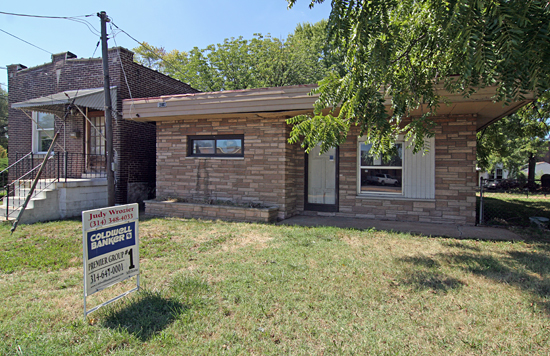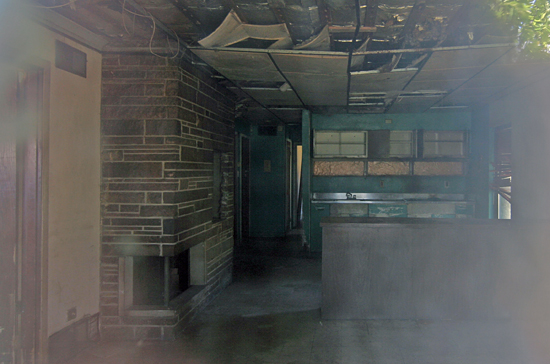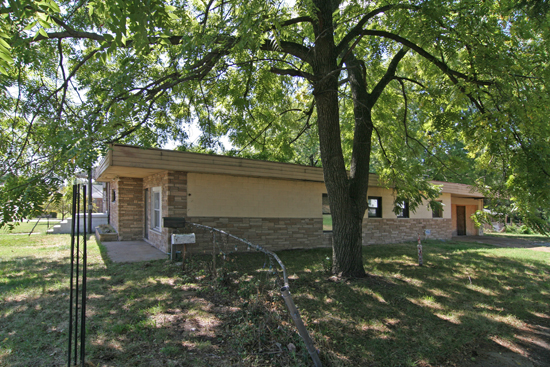4084 Meramec
South St. Louis City
This 1956 mid-century modern home plunked down in the middle of pre-WW2 homes in deep South St. Louis has been covered before. Scroll down half way at this link.
It is now for sale. Here’s the info.
The home is a $19,900 As Is foreclosure that needs a lot of work. Neglect has led to much water damage and remuddling. The extra photos that the realtor includes work hard to avoid revealing its raggedy shape, though the price is a dead giveaway. Here’s one photo that was not included:
Sorry it’s such a crappy photo. It was taken through an encrusted window. But it does show that some of the original mid-century fabric remains. This is exactly the type of information that someone interested in rehabbing an MCM home would want to know: is there something there that’s worth my money and effort?
One highly unusual (thus admirable) aspect of this listing is that the realtor does NOT ever use the phrase – or even imply – “tear down.” Homes of this vintage are regularly classified as tear downs, especially when they are in desirable zip codes on land that is, on paper, more valuable than the house.
But if a home is in good condition, isn’t it a bit manipulative to call something a “tear down?” It’s a bit of judgement casting, an assumption that everyone who runs across the listing will think that a mid-century modern home is horrid.
I completely understand the financially-motivated aspects of labeling a home a tear down. Everyone involved in the sale wants to get paid. But marketing has a very powerful influence everywhere, including real estate. How many under-performing stick-and-tissue new build homes in the deep exurbs have been purchased based on painting a pretty picture? And rechristening condos as villas has brought new life to a traditional form of high-density, low maintenance living. So words matter, and some aspects of pegging mid-century homes for demolition is absolutely suggestive selling.
It is a fact that any home that you’re not the first owner of is going to need some remodeling. The cost of changes you intend to make are typically factored into what you’re willing to pay for a home. And there are millions of buyers who want to rehab a home, either to their liking or back to its historical authenticity. We all understand this as a selling feature for pre-WW2 homes. But in the world of the Multiple Listing Service (MLS), they are quick to label homes from after WW2 to the 1970s as tear downs.
Actually, the MLS has yet to upgrade their descriptions so a realtor can choose phrases like “mid-century modern” or “modern ranch” as a choice for the style of home. It is a fact that sympathetic realtors and MCM-motivated buyers have to comb through mountains of homes by age to zero in on what is wanted. Why is an easily-identifiable group of willing buyers left to work so hard to find their home? Is it that difficult to add some new style categories to the MLS?
It always boils down to education. And in the case of real estate, realtors who can identify and serve this new subset of mid-century modern buyers will emerge financially victorious. Wouldn’t other realtors, logically, like to benefit from this as well? So that’s the argument for updating the MLS: do you wanna get paid? MCM lovers are willing to pay.
MCM Realtors in St. Louis
In St. Louis, we do have some enlightened realtors that know their MCM and the audience who wants to buy them.
• Shannon Howard highlights St. Louis Homes with Soul on her realtor website. She also gives in-depth heads-up on her NOCO site, like this amazing MCM in Ferguson.
• Ted Wight knows a good MCM home when he sees one, and shares sales info and amazing photos of such on his blog, St. Louis Style. He also walks the talk, having just recently purchased a William Bernoudy home, making him a realtor who is also saving mid-century homes in desirable locations from being torn down.
• Ginger Fawcett knows a good MCM when she finds it. Here’s her LiveLocal. And her frustration at MLS listings making it difficult to ID mid-century homes motivated her ModernSTL board membership. Ginger’s desire is to educate fellow realtors about the MCM market, which then advocates changes in how these homes are listed. Her educational activities include a Parade of Homes, where multiple realtors put their MCM homes on an open house tour so MCM buyers can see multiple, desirable properties in one day.
If you’re in the market for a Metro St. Louis mid-century modern home, these are the three realtors that I know who fully understand what you’re looking for, and can ease the burden of what is, typically, a time-consuming MLS search.




Thanks for the kind words, Toby! Much appreciated!
As a realtor who specializes in unique mid-century properties, I am often frustrated by agents who will only consider a teardown. They simply don’t see value in a “dated” house with original finishes and quirky architecture. It can also be difficult to convince appraisers that there truly is a market for MCM homes, particularly if the house doesn’t have a basement or has a layout that doesn’t conform to current trends.
But all it takes is educating people. More and more often lately, I’m meeting agents & appraisers who want to learn, and who want to see what I see in terms of quality and market value. So I’m optimistic! :))
Too much HGTV has taken its toll on all vintage and historic homes. Unfortunately, Americans who normally think of themselves as independent thinkers show little independence when it comes to housing. Most want what “everyone else wants” in their market. In Portland OR we see a fair demand for mid-century. Problem is the housing in the desireable inner city is built prior to WWII. So many young buyers transform Victorians and Bungalows into modern style without much success.
Brian is right, I don’t like it, but the market will figure out how to meet the demand.
he does acknowledge the degradation of historic fabric. it’s sad but the redevelopment of inner-ring suburbs does have a better environmental impact than new Wildwoods.
for those of us who are against teardowns, the trend in new construction is towards smaller homes. that may abate some of the lesser ones, but Morton May’s house would still be history in this scenario.
It’s marketing.
Thanks,
Quite possibly some of the most annoying spam I’ve ever seen. So many “facts”, lol!
Simply, a teardown is what a buyer has determined is property whose value is in the land.
The buyer most likely will redevelop the infill property with new construction.
Part of the qualification is easy math – if homes surrounding your home (on a similar lot) are selling for 2-3x the value of yours – the economics for your home being a “teardown” may be viable.
The smart guys over at Wikipedia call a teardown:
A teardown refers to a process in which a real
estate company or individual buys an existing home and then demolishes and replaces it with home and then demolishes and replaces it with a new one.
Frequently, the new building is larger than the previous one, in an attempt to increase the appeal of the property to prospective buyers or take advantage of rising property values.[1] The process is especially common in older suburbs, where people wish to have larger homes, and yet do not want to move to far-out exurbs or new developments. A common result is the gradual degradation of the historic character of the neighborhood. The redevelopment of Brownfield land also usually involves teardowns, but the term is often limited to residential properties.
The market size for this unique property type is very large, arguable about 25% of the marketplace. Buyers want them and sellers have them – consumers should be able to find the sector on the Internet.
For us, we use the word “teardown” because that is name the media and market participants around the English speaking world use to describe the property type – plus we own the domain:)
Thanks,
Brian Hickey
teardowns.com